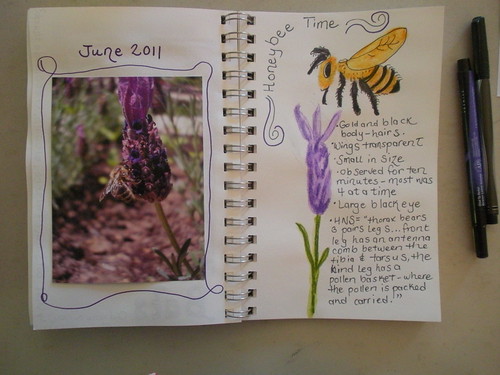“During many years naturalists have been studying the habits and adaptations of the honeybees, and, as yet, the story of their wonderful ways is not half told. Although we know fairly well what the bees do, yet we have no inkling of the processes which lead to a perfect government and management of the bee community; and even the beginner may discover things never known before about these fascinating little workers.”We have lots of honeybees and bumblebees in our area of California. I love to watch them on my lavender plants and on my other garden flowers. I love to sit and let them buzz up right next to me so I can see them clearly. I have had a sting or two in my life but usually because I stepped on a bee in the grass with bare feet.
Handbook of Nature Study, page 391

“The structure of honeycomb has been for ages admired by mathematicians, who have measured the angles of the cells and demonstrated the accurate manner in which the rhomb-shaped cell changes at its base to a three-faced pyramid; and have proved that, considering the material of construction, honeycomb exemplifies the strongest and most economic structure possible for the storing of liquid contents.”I am fascinated with the geometry of the honeycomb and read with interest the section in the Handbook on honeycombs starting on page 395. Maybe it has something to do with my love for eating honey.
Handbook of Nature Study, page 395
Outdoor Hour Challenge #27
Focus on Insects-Bees
(You may also like to look at the Yellow Jacket and Mud Dauber Challenge.)
1. This week read about bees in the Handbook of Nature Study, pages 384-400. There are sections on leaf-cutter bees, carpenter bees, bumblebees, and honeybees in the Handbook of Nature Study. You may not have every kind of bee in your location but I found the information very interesting and maybe someday I will have the opportunity to observe all the different kinds of bees discussed in the book. Remember our focus right now is on insects so if you don’t find a bee to observe, you can always look for other insects to study.
2. Your 15-20 minutes of outdoor time this week can be spent looking for insects. Make your goal just to get outside in your own backyard and find something to observe with your child. If during that time you find an insect, take as long as you can to describe what it looks like, what it is doing, and then try to come up with some questions to answer later with your Handbook of Nature Study or a field guide. If you find a bee to observe during your nature time or at another time during the week, use the opportunity to relate some facts from your reading in the Handbook of Nature Study.

3. Give the opportunity for a nature journal entry. It might be hard to draw a bee from your outdoor time but it would be a great idea to find a photo of a bee online or use the diagram on page 391 to make an entry about bees in your journal. Another idea is to use a notebooking page and fill it in with your thoughts and observations from your Outdoor Hour time.
4. If you are keeping a running list of insects you have observed during this focus period, add the insect’s name to the list.

Post an entry on your blog sharing your experiences. You can link up by clicking the carnival button or you can send them directly to me: harmonyfinearts@yahoo.com.














































